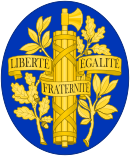
Back Département Afrikaans Département ALS Departamentos de Francia AN أقاليم فرنسا Arabic اقاليم فرنسا ARZ Departamentos de Francia AST Fransa departamentləri Azerbaijani Departemén ring Prancis BAN Дэпартаменты Францыі Byelorussian Дэпартамэнты Францыі BE-X-OLD
| Departments of France Départements (French) | |
|---|---|
 | |
| Location | France |
| Found in | Regions |
| Number | 101 (not including Metropolis of Lyon) (as of January 2021) |
| Possible types | |
| Populations | Largest: Nord, Hauts-de-France—2,613,000 (2022 census) Smallest: Lozère, Occitanie—83,000 (2022 census) |
| Areas | Largest: French Guiana—83,533.9 km2 (32,252.6 sq mi) Smallest: Paris, Île-de-France—105.4 km2 (40.7 sq mi) |
| Densities | Largest: Paris, Île-de-France—20,755/km2 (53,760/sq mi) Smallest: French Guiana—3.5/km2 (9.1/sq mi) |
| Government | |
| Subdivisions | |
| This article is part of a series on the |
| Administrative divisions of France |
|---|
 |
| Administrative divisions |
| Intercommunality |
| Communes |
| Overseas France |
| Geocodes of France |
|
|
|
|
 |
|---|
In the administrative divisions of France, the department (French: département, pronounced [depaʁtəmɑ̃] ⓘ) is one of the three levels of government under the national level ("territorial collectivities"), between the administrative regions and the communes. Ninety-six departments are in metropolitan France, with an additional five constituting overseas departments, which are also classified as overseas regions. Departments are further subdivided into 333 arrondissements and 2,054 cantons (as of 2023).[1] These last two levels of government have no political autonomy, instead serving as the administrative basis for the local organisation of police, fire departments as well as, in certain cases, elections.
Each department is administered by an elected body called a departmental council (sg. conseil départemental, pl. conseils départementaux). From 1800 to April 2015, these were called general councils (sg. conseil général, pl. conseils généraux).[2] Each council has a president. Their main areas of responsibility include the management of a number of social and welfare allowances, of junior high school (collège) buildings and technical staff, and local roads and school and rural buses, and a contribution to municipal infrastructures.[3] Local services of the state administration are traditionally organised at departmental level, where the prefect represents the government; however, regions have gained importance since the 2000s, with some department-level services merged into region-level services.
The departments were created in 1790 as a rational replacement of Ancien Régime provinces with a view to strengthen national unity;[4] the title "department" is used to mean a part of a larger whole.[5] Almost all of them were named after physical geographical features (rivers, mountains, or coasts), rather than after historical or cultural territories, which could have their own loyalties, or after their own administrative seats. The division of France into departments was a project particularly identified with the French revolutionary leader the Abbé Sieyès,[6][7] although it had already been frequently discussed and written about by many politicians and thinkers. The earliest known suggestion of it is from 1665 in the writings of d'Argenson.[8] They have inspired similar divisions in many countries, some of them former French colonies. The 1822 territorial division of Spain (reverted due to the 1823 French intervention ending the trienio liberal) and the 1833 territorial division of Spain, which forms the basis of the present day Provinces of Spain with minor modifications, are also based on the French model of departments of roughly equal size.[9]
Most French departments are assigned a two-digit number, the Official Geographical Code, allocated by the Institut national de la statistique et des études économiques (Insée).[10] Overseas departments have a three-digit number. The number is used, for example, in the postal code and was until recently used for all vehicle registration plates. Residents commonly use the numbers to refer to their own department or a neighbouring one, for example inhabitants of Loiret may refer to their department as "the 45". More distant departments are generally referred to by their names, as few people know the numbers of all the departments.
In 2014, President François Hollande proposed abolishing departmental councils by 2020, which would have maintained the departments as administrative divisions, and transferring their powers to other levels of governance.[11] This reform project has since been scrapped.
- ^ "Code officiel géographique au 1er janvier 2021 | Insee". www.insee.fr. Retrieved 9 November 2021.
- ^ Ministère de l'intérieur, Les élections départementales : comprendre ce qui change (in French), archived from the original on 10 August 2016, retrieved 30 July 2015
- ^ "Quelles sont les compétences des départements ?". Vie publique.fr (in French). Retrieved 5 November 2021.
- ^ 83 départements sont créés en France (in French), retrieved 5 November 2021
- ^ Rey, Alain (25 October 2011). Dictionnaire Historique de la langue française (in French). NATHAN. ISBN 978-2-321-00013-6.
- ^ "Sous le Sénat de l'Empire - Personnalités - Emmanuel-Joseph Sieyès - Sénat". senat.fr. Retrieved 5 November 2021.
- ^ "Création du département" (in French). Archives départementales du Puy-de-Dôme. Retrieved 5 November 2021.
- ^ "Carte de France à la révolution: création des départements". cartesfrance.fr. Retrieved 5 November 2021.
- ^ Turchetti, Mario (2005). La Suisse de la Médiation dans l'Europe napoléonienne (1803-1814): actes du colloque de Fribourg (journée du 10 octobre 2003) (in French). Saint-Paul. p. 46. ISBN 978-2-8271-0983-8.
- ^ "🔎 Code INSEE : définition et explications". Techno-Science.net (in French). Retrieved 5 November 2021.
- ^ "François Hollande fixe les régions à 14 et la fin des départements à 2020". La Gazette des Communes (in French). Retrieved 5 November 2021.